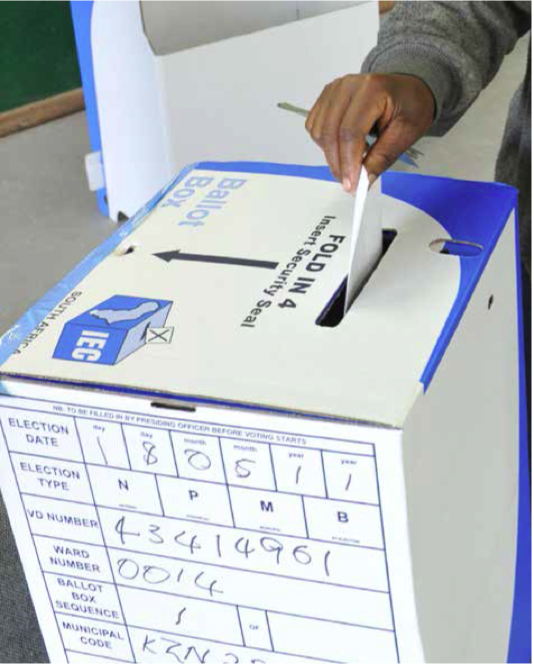All eyes now turn to process of counting votes in 2019 democratic elections
Voting stations across South Africa closed at 9 pm on Wednesday in the sixth democratic elections.

- Country:
- South Africa
All eyes have now turned to the critical process of counting votes in the 2019 National and Provincial Elections.
Voting stations across South Africa closed at 9 pm on Wednesday in the sixth democratic elections.
The Electoral Commission (IEC) said it is pleased with what it described as “the smooth progress of voting”, despite isolated incidents where voting operations were adversely affected by inclement weather, community unrest, power outages and some logistical challenges.
“Strong thunderstorms were reported in the early evening in the Free State, where 16 temporary voting stations in Manguang were blown down by strong winds and where heavy rain affected the conditions underfoot.
“In Nelson Mandela Bay and Craddock in the Eastern Cape, heavy rain and winds also affected operations in more than 30 temporary voting stations,” the IEC said in a statement shortly after the closure of voting stations on Election Day.
In a number of areas, voting after dark was affected by power outages, including in KwaZulu-Natal (specifically Umlazi), Limpopo (Vuwani and Giyani) and Gauteng (parts of Johannesburg).
The power outages were as a result of cable theft, weather-related outages and other unscheduled interruptions.
The Electoral Commission joined forces with power utility Eskom and local municipalities to rapidly restore power in affected areas.
“Voting stations have also been equipped with some emergency LED lighting and lighting provided by the COGTA [Cooperative Governance and Traditional Affairs] as back-up,” said the IEC.
How to vote counting works
Counting of votes is done within the voting station in front of political party representatives, known as party agents and independent observers.
“The first step in the process is to check the seals and open the ballot boxes. The ballots contained therein are then reconciled with those issued, any remaining unused ballots and any ballots which may have been cancelled,” the IEC said.
Ballot boxes containing special votes are also opened and the contents are verified against lists of authorised special voters before being added to the count.
Once the reconciliation is completed, the marked ballots are sorted into piles according to the party voted for. For ease of counting, the ballots are grouped together in batches of tens and hundreds.
Where the choice of the voter cannot be immediately and easily determined, these ballots are set aside for further scrutiny. Where the intention of the voter is then determined, the ballots are added to those party piles.
Where the intention of the voter cannot be reasonably determined – or where the ballot is obviously spoiled – these are grouped together as spoiled ballots. The Presiding Officer makes the final determination of this.
The ballots for each party are counted and recounted to ensure accuracy and the results captured on two duplicate results slips, which reflect the voting station, the number of cast ballots, the number of votes for each party and the number of spoiled ballots.
The results slips are signed by the present party agents, who are also encouraged to record the details of the results for themselves (including by taking a photograph of the results to slip).
One result slip is then posted on the door of the voting station, while the other is taken by the Presiding Officer to the local IEC office, where it is scanned and the data entered into the results system using a double capture system to minimise any human error.
Once audited by independent auditors, the results are released and are simultaneously visible to all those with access to the results system, including the Electoral Commission, political parties, observers and the media. Parties can verify the captured results against their copy of the original results slip to ensure accuracy.
“The length of the process depends on a range of factors, including the number of votes cast at the voting station, the number of political parties contesting the ballots, and the number of clearly marked or unclearly marked ballots.
“The conditions of the voting station – including whether it is a tent or permanent structure and the quality of the lighting and facilities - also greatly affect the length of the process,” the IEC said.
Once the final results are posted, all materials from the voting station are packed and transported under secure transport to capture sites, where they are logged and stored. By law, all ballots must be securely retained for six months in case of objections.
The first results from voting districts with the smallest number of voters are expected to reflect on the results system before midnight tonight.
(With Inputs from South African Government Press Release)
ALSO READ
IMD using AI, machine learning to enhance weather forecasts: Mrutyunjay Mohapatra
Weather is the hot topic as eclipse spectators stake out their spots in US, Mexico and Canada
IMD using AI, machine learning for weather forecasts, says DG Mrutyunjay Mohapatra
Eclipse weather forecast: clear skies in the Northeast, clouds in Texas
Weather is the hot topic as eclipse spectators stake out their spots in US, Mexico and Canada










